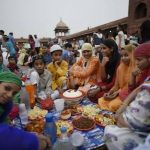Diabetes and fasting during Ramadan.
Controversy over fasting by patients with diabetes mellitus in the Holy month of Ramadan
Here, I try to present data from studies, especially one (1) large epidemiological research regarding fasting in the Holy month of Ramadan by patients with diabetes mellitus. I also give advice on diet, nutrition and exercise for patients with diabetes mellitus fasting during the Holy month of Ramadan.
The results of the population-based Epidemiology of Diabetes and Ramadan carrying the acronym “EPIDIAR study” showed (in 12,243 people with diabetes from 13 Islamic countries) that 43% of patients with type 1 diabetes and 79% of patients with type 2 diabetes fast during Ramadan, leading to the estimation that some 40-50 million people with diabetes worldwide fast during Ramadan.

Credit: Vox
Patients with diabetes mellitus are required to eat regularly and take their medications to maintain physiological (normal) level of blood glucose.
As a reminder, Muslims who fast during Ramadan must abstain from eating, drinking, use of oral medications, and smoking from predawn to after sunset. However, there are no restrictions on food or fluid intake between sunset and dawn.
Most people consume two meals per day during this month, one after sunset, referred to in Arabic as Iftar (breaking of the fast meal), and the other before dawn, referred to as Suhur (predawn). Fasting is not meant to create excessive hardship on the Muslim individual.
The Koran specifically exempts the sick from the duty of fasting (Holy Koran, Al-Bakarah, 183-185), especially if fasting might lead to harmful consequences for the individual.
Patients with diabetes fall under this category because their chronic metabolic disorder may place them at high risk for various complications if the pattern and amount of their meal and fluid intake is markedly altered.
This exemption represents more than a simple permission not to fast; the Prophet Mohammad (SAW) said, “God likes his permission to be fulfilled, as he likes his will to be executed.”
Nevertheless, many patients with diabetes insist on fasting during Ramadan, thereby creating a medical challenge for themselves and their health care givers. It is therefore important that medical professionals be aware of potential risks that may be associated with fasting during Ramadan.
Here, I try not to use the terms “indications” or “contraindications” for fasting, because fasting is a RELIGIOUS issue for which patients make their own decision after receiving appropriate advice from religious teachings and from their own health care providers.
However, I emphasize that fasting, especially among patients with type 1 diabetes with poor glycemic control, is associated with multiple risks.
EPIDIAR study, clearly showed that fasting during Ramadan increases the risk of severe hypoglycemia (very low level of blood glucose, defined as hospitalization due to hypoglycemia) some 4.7-fold in patients with type 1 diabetes (from 3 to 14 events per 100 people per month and 7.5-fold in patients with type 2 diabetes (from 0.4 to 3 events per 100 people per month.
Furthermore, EPIDIAR study showed a fivefold increase in the incidence of severe hyperglycemia (very high level of blood glucose, requiring hospitalization) during Ramadan in patients with type 2 diabetes (from 1 to 5 events per 100 people per month and an approximate threefold increase in the incidence of severe hyperglycemia with or without ketoacidosis in patients with type 1 diabetes (from 5 to 17 events per 100 people per month.
Hyperglycemia in the EPIDIAR study may have been due to excessive reduction in dosages of medications to prevent hypoglycemia.
Patients who reported an increase in food and/or sugar intake had significantly higher rates of severe hyperglycemia.
DIET during Ramadan should not differ significantly from a healthy and balanced diet. The common practice of ingesting large amounts of foods rich in carbohydrate and fat, especially at the sunset meal, should be avoided.
Because of the delay in digestion and absorption, ingestion of foods containing “complex” carbohydrates may be advisable at the predawn meal, while foods with more simple carbohydrates may be more appropriate at the sunset meal.
It is also recommended that fluid intake be increased during non-fasting hours and that the predawn meal be taken as late as possible before the start of the daily fast.
Normal levels of physical activity may be maintained.
However, excessive physical activity may lead to higher risk of hypoglycemia and should be avoided, particularly during the few hours before the sunset meal.
If Tarawaih prayer (multiple prayers after the sunset meal) is performed, then it should be considered a part of the daily exercise program.
In some patients with poorly controlled type 1 diabetes, exercise may lead to extreme hyperglycemia.
All patients should understand that they must always and immediately end their fast if hypoglycemia (blood glucose of less than 60 mg/dl [3.3 mmol/l]) occurs, since there is no guarantee that their blood glucose will not drop further if they wait or delay treatment.
The fast should also be broken if blood glucose reaches less than70 mg/dl (3.9 mmol/l) in the first few hours after the start of the fast, especially if insulin, sulfonylurea drugs, or meglitinide are taken at predawn. Finally, the fast should be broken if blood glucose exceeds 300 mg/dl (16.7 mmol/l). Patients should avoid fasting on “sick days.”
These are the thoughts of:
Sa’eed Halilu Bawa
Senior Lecturer (Associate Professor) at University of the West Indies, St. Augustine Campus, Trinidad.
Studied Food and Nutrition Sciences, Dietetics at Kaduna Polytechnic, Nigeria; Warsaw University of Life Sciences, Poland.
























